|
|
|
Sort Order |
|
|
|
Items / Page
|
|
|
|
|
|
|
| Srl | Item |
| 1 |
ID:
122224
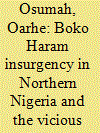

|
|
|
|
|
| Publication |
2013.
|
| Summary/Abstract |
The phenomenon of the Boko Haram insurgency in Northern Nigeria has generated many security concerns. This article explores the implications of the Boko Haram insurgency in Northern Nigeria for internal security. The article, which relies on a study of secondary sources of data, reveals that the insurgency has spawned varied implications such as an international image crisis, huge economic losses, a health and humanitarian crisis, a huge burden on the security apparatuses, arms proliferation, and endangered national unity. It holds that the insurgency is essentially interlinked with a breakdown of the social contract manifested in opportunistic behavior, economic stagnation, and lack of functioning institutional mechanisms for policy conduct and conflict resolution. Owing to the security menace posed by the insurgency, the article recommends that the root causes of the insurgency should be tackled rather than relying on reactive measures that cannot guarantee enduring peace and internal security.
|
|
|
|
|
|
|
|
|
|
|
|
|
|
|
|
| 2 |
ID:
122219
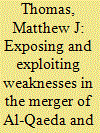

|
|
|
|
|
| Publication |
2013.
|
| Summary/Abstract |
On 9 February 2012 the Somali terrorist organization al-Shabaab officially merged with al-Qaeda. While the significance of the merger is highly contested, it does expose internal weaknesses within the two organizations along ideological, clan, and sectarian lines. The article identifies three key weaknesses of the merger and concludes with a discussion of al-Qaeda's growing presence in trans-Saharan Africa.
|
|
|
|
|
|
|
|
|
|
|
|
|
|
|
|
| 3 |
ID:
122225
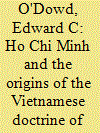

|
|
|
|
|
| Publication |
2013.
|
| Summary/Abstract |
In a very important sense, the Vietnamese military history of the communist era began in 1941, when Ho Chi Minh prepared 'Guerrilla Tactics' (Cach Danh Du Kich).1
The publication of this essay, which was a manual on the tactics, techniques, and procedures of guerrilla warfare, preceded the founding of the first armed propaganda unit (Tuyen Truyen Doi Vo Trang) on 22 December 1944, which later became the People's Army of Vietnam (PAVN, Quan Doi Nhan Dan); as well as the revolutionary writings of Truong Chinh (1946-1947) and Vo Nguyen Giap (1959). The fact that 'Tactics' was published by the Viet Minh reinforces the claim made by the PAVN that it was the first authoritative Vietnamese writing on this important subject.
|
|
|
|
|
|
|
|
|
|
|
|
|
|
|
|
| 4 |
ID:
122223
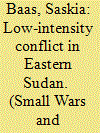

|
|
|
|
|
| Publication |
2013.
|
| Summary/Abstract |
This article discusses the development of a low-intensity conflict in Sudan's eastern region between 1994 and 2006. Drawing on data collected in the region in 2009, recruitment processes within three different insurgent groups are analysed and compared, paying attention to the impact of these processes on insurgents' organisational development and military capacity. The peace process in Eastern Sudan is further discussed, focusing specifically on the disarmament, demobilisation, and reintegration (DDR) programmes for former insurgents. The article finally discusses current developments and draws conclusions regarding the risk of renewed rebellion in Eastern Sudan.
|
|
|
|
|
|
|
|
|
|
|
|
|
|
|
|
| 5 |
ID:
122220
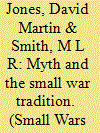

|
|
|
|
|
| Publication |
2013.
|
| Summary/Abstract |
In recent years a number of commentators have posited that the British reputation for conducting small wars has suffered in the wake of setbacks in Iraq and Afghanistan. The argument here contests whether such a tradition can be truly said to have ever existed. A close examination of this supposed tradition reveals it to be a myth. In fact, rarely have the British armed forces claimed a facility for counter-insurgency or small war. Invariably, commentators outside the Army have ascribed the tradition to them. Most notably, commentators in the United States keen to discern practices of minimum force or rapid institutional learning generated the narrative of British COIN expertise. Ultimately, what this myth reveals is that, when deconstructed, it is political will, not an ingrained understanding of fighting insurgencies, that has determined Britain's success, or otherwise, in so-called small wars.
|
|
|
|
|
|
|
|
|
|
|
|
|
|
|
|
| 6 |
ID:
122217


|
|
|
|
|
| Publication |
2013.
|
| Summary/Abstract |
Since Operation Enduring Freedom, Central Asian militants, such as the Islamic Movement of Uzbekistan, have fled to Pakistan from their previous strongholds in Afghanistan. However, many militants have begun returning to Central Asia. Thus questions are raised as to what extent militancy has the potential to thrive with the pending North Atlantic Treaty Organization withdrawal from Afghanistan set for 2014? Is militancy a legitimate security threat to Central Asia? What strategies might militants implement? Thus, this article examines the current state of militancy, analyzes militant trends, introduces Afghanistan and Pakistan into the Central Asian equation, and determines the militants' capability and overall strategy. The article concludes that militant Islam, regardless of its current numbers, remains a viable threat to regional security, Afghanistan will be an essential factor for the future of Central Asian militancy, and the form this re-emergence will take becomes apparent.
|
|
|
|
|
|
|
|
|
|
|
|
|
|
|
|
| 7 |
ID:
122221
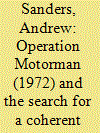

|
|
|
|
|
| Publication |
2013.
|
| Summary/Abstract |
The role of the British Army in Northern Ireland during Operation Banner (1969-2007) is an instructive case study of counterinsurgency operations as well as an important chapter in recent British military history. Given troops deployed to the province as aid to the civil power, it is particularly useful in discussions about the principle of minimum force. This article seeks to explore the issue of minimum force through the example of Operation Motorman, the Army's successful attempt to remove the barricades, which had established so-go areas for the security forces in Northern Ireland.
|
|
|
|
|
|
|
|
|
|
|
|
|
|
|
|
| 8 |
ID:
122222
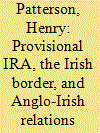

|
|
|
|
|
| Publication |
2013.
|
| Summary/Abstract |
Using hitherto largely unexplored governmental archives from London and Dublin, this article focuses on the security challenges arising from the existence of the land frontier between the Republic of Ireland and Northern Ireland and the significance of issues of cross-border security cooperation for Anglo-Irish relations from the beginning of the Troubles until the Anglo-Irish Agreement in 1985. It argues that the relatively safe haven of the Republic was essential to the longevity of the IRA's campaign and that successive Irish governments exploited British security concerns to expand their political influence on Northern Ireland.
|
|
|
|
|
|
|
|
|
|
|
|
|
|
|
|
| 9 |
ID:
122218


|
|
|
|
|
| Publication |
2013.
|
| Summary/Abstract |
There were several high-profile violent incidents in 2011 in Kazakhstan, including several bombings, shootings that targeted police, and a protest turned clash that resulted in a number of deaths. Some of the perpetrators reportedly had links with radical religious groups. An overlooked aspect of the violence is how it is reported in Kazakhstan. There are active, competent media in Kazakhstan, which are largely unknown in the West. An examination of these incidents using the media in Kazakhstan can provide a unique insight into what took place. While Western sources quickly blamed radical religious groups with international connections, media in Kazakhstan have found that there are other reasons for the violence.
|
|
|
|
|
|
|
|
|
|
|
|
|
|
|
|
|
|
|
|
|